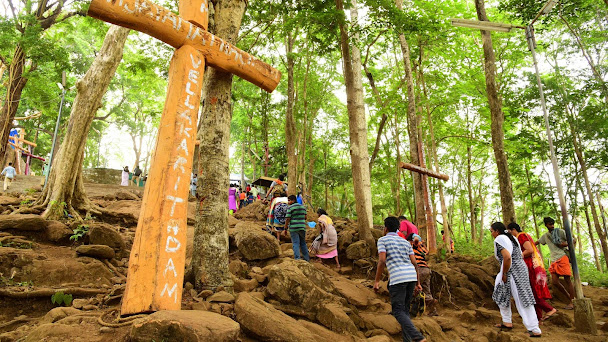Pazhavangadi Temple: The soldier's Ganapathy
For anyone who comes to Trivandrum, a visit to Padmanabhaswamy temple is a must but what completes the visit is breaking a coconut at the revered Pazhavangady Ganapati temple. This activity along with the origin of the temple is one that takes you back to the time of the Travancore Kings & one that compels you to believe in human endurance & faith. The Pazhavangadi temple is a landmark in the East fort area & one that can never be missed by anyone. The temple stands on a small land & is said to have been built on the walls of the East Fort which does not exist anymore. The temple, idol & its rituals all have stories of their own. The story of the temple starts in the 18th century.
The old capital of Travancore was Padmanabhapuram & the palace complex there was protected by a large fort which was secured by the Nair Brigade. There was a Kavu near the wall dedicated to Melankottu Yakshi who was a fierce dispensation. The soldiers were afraid to patrol in the night as they constantly were attacked by the Yakshi & it was a common sight for other soldiers to find their companion near the kavu unconscious the next morning. The fear among the Nair Brigade was immense but the King or oracles from that period were unable to find a solution. It so happened that one day a new soldier was posted at the wall & as per rituals he went to the nearby Valliyoor river to bathe. As he was walking back from the river his leg got caught in a rock. He tried to pull himself free but was unable to do so. He then knelt down & tried to pick the rock, to his surprise it was an idol of Lord Ganapathy. The idol was in a sitting posture with his right leg folded which was a unique form. Being an ardent devotee of Lord Ganapathy, the soldier took the idol with him to the bastion. It so happened that the Yakshi could not come close to the soldier all night & the other soldiers were surprised to see him all well the next morning. The soldier then explained the reason to all & from that day the idol was worshipped by all in the brigade.
The then King of Travancore acknowledged the belief of his men & built a small temple to house the idol near the walls. The idol continued to be worshipped by the Nair brigade & they were given the responsibility for all rituals & upkeep at the temple. By the end of the 18th century, the capital of the Travancore Kingdom was shifted to Thiruvananthapuram & in 1795 AD the Garrison was set up at East Fort. The Travancore King Sri Karthika Thirunal earmarked this small area around the fort which was a market for fruits (Pazha Angadi). The temple was built along the walls & the Nair Brigade again were given the responsibility for the upkeep of the temple. Over a period of time the place changed names to Pazhavangadi & became known as the place of Lord Ganapathi.
The current temple structure was built in 1860 & the Indian Army was given the responsibility of the temple which continued even after independence & today is under the Pangode Military camp. The temple has two idols, one is a golden idol & the other is a larger idol. The temple is also flanked on all sides by statues depicting Lord Ganesha in different forms.
The ritual of breaking coconuts is also based on the soldiers belief. As per tradition, the soldiers everyday made it a habit to break a coconut to pray for a day with no ambush or fights around. The belief that if the coconut broke in equal proportions the wish would be fulfilled made the soldiers break coconut countless times until they achieved this. This thought still lingers among all devotees who come to the temple & you can find sacks of coconuts being hurled into the stone walls in front of the idol by all visitors. The architecture of the temple is also quite interesting as it has a Dravidian style similar to that of the other Travancore temples. The old structure which was present for over 130 years is now overhauled & a new design has taken over the complex giving it a new maroon façade. The tiled roofs & well crafted doors give the temple a grand outlook now.
It is important to know that the temple’s origin is based on the belief of the soldiers that there is always a protector around. This belief continues to attract all the devotees to the Pazhavangadi temple even today which is a landmark of Trivandrum.
.jpeg)



Comments
Post a Comment